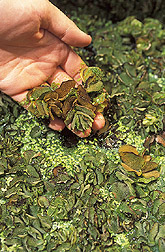This page has been archived and is being provided for reference purposes only. The page is no longer being updated, and therefore, links on the page may be invalid.
|
Read the magazine story to find out more. |
Weevil Wreaks Havoc on Giant SalviniaBy Alfredo FloresSeptember 7, 2004 Giant salvinia, a free-floating invasive fern sometimes referred to as one of the world's worst water weeds, may have met its match, thanks to the efforts of Agricultural Research Service (ARS) scientists. In lakes and ponds in Texas and Louisiana, two-foot-thick mats of giant salvinia, known scientifically as Salvinia molesta, block out sunlight and use up oxygen, making it hard for some forms of aquatic life to survive beneath them. Notorious for its presence in slow-moving, quiet, freshwater systems, its rapid growth and tolerance to environmental stress make it an aggressive, competitive species. It can quickly take over aquatic environments, restricting water use and harming local economies dependent on recreational activities like fishing and waterfowl hunting. ARS scientists at the Invasive Plant Research Laboratory in Fort Lauderdale, Fla.—led by entomologist Phillip W. Tipping and center director Ted D. Center—have been getting good results from releasing a diminutive weevil, Cyrtobagous salviniae, that loves to consume salvinia. Just one-tenth-inch long, this dark-colored, long-nosed biological control agent is proving itself effective against S. molesta. The adult female weevil lays her eggs in cavities she creates by chewing into salvinia's rootlike structures, or rhizomes, and the petioles that attach the leaves to the rhizomes. The larvae that hatch feed on flower buds before tunneling into the rhizomes, where they inflict the most serious damage. Interestingly, this highly specific insect feeds only on salvinia of South American origin, rejecting other closely related salvinia species from Africa and Europe. Weevils from Brazil were released in October 2001 at sites in Texas and Louisiana. Within two years, the salvinia mats almost completely collapsed, and water bodies formerly choked by the weed are now mostly open water. As the giant salvinia infestations have declined, so have the populations of the weevil, thereby striking a balance between the two. The end result is a permanent suppression of a fearsome weed into an almost unnoticeable background plant. Read about this research in the September 2004 issue of Agricultural Research magazine. ARS is the U.S. Department of Agriculture's chief scientific research agency. |

